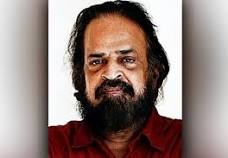Achuthan Kudallur (1945-2022)

A significant force in India’s contemporary abstract art movement and a mentor to many, Achuthan Kudallur, is a well-respected artist from Madras. A writer-turned-painter, his luminous canvases, pulsating with colour, drew international attention to the Madras Art Movement in the 1970s. He won multiple awards, including the Tamil Nadu Lalit Kala Akademi award in 1982 and the National Academy Award in 1988 and exhibited his work widely, both nationally and internationally.
Born in 1945 in the hamlet of Kudallur in Kerala, Kudallur first did his diploma in engineering. He however soon turned to art, first as a writer and then as a painter. He was however mostly a self-taught painter, with the most formal teaching being at evening art classes at the Government College of Arts & Crafts in Madras. He was a voracious reader and writer and had done a series of short stories published in Malayalam magazines.
Although he started out as a writer, Kudallur soon replaced the pen with the brush in the 1970s. While he commenced his artistic journey with figurative works, Kudallur moved to abstract art in the 1980s and this was a defining period in the artist’s life. ‘For Achuthan, painting was not a dialogue, not a conversation but a communication with colour. To him, colour was emotion, expression, joy, melancholy and celebration. His canvas was about layers of colours, however, each shade and stroke were there for a reason. There was nothing that was not meant to be’, says his fellow artist and friend K. Muralidharan.
For Kudallur, abstraction was far from an easy way out. While he was in search of a better medium for self-expression, he switched to painting abstracts as he believed abstracts revealed his true understanding of emotions. In 1989, he participated in a group show in India and Czechoslovakia. During 1990-92, he took part in a group of exhibitions in Mumbai, Chennai, Kolkata and France.
The artist held sixteen solo shows all over India. He had several institutional commissions including Air India, Mumbai. His works have been displayed in the National Gallery of Modern Art, New Delhi, Glenberra Museum, Japan, and with other collectors in India and abroad.
Each painting of Achuthan takes a colour as a source of inspiration. He described each of them with affection as 'his blue', 'his yellow' or 'his red'. His works are oddly instinctive and emotional. They are the result of systematic thought and recreation of colour on the canvas where the dots, dashes, brackets and crosses are still visible in the final work.
The artist himself is a charismatic, intelligent figure though also shy and emotional with regard to criticism or speculation by his audience. This is especially true in relation to his choice of abstract art. Kudallur believed, “What is important is the intensity of life, how you have reacted to your segment of time, how it radiated light and strength to others.” Clearly, those words formed the canvas of his life.
Beyond his artistic practice, Kudallur was also a passionate advocate for the preservation and promotion of Indian art and culture. Through his involvement in cultural initiatives, exhibitions, and educational programs, he sought to create platforms for emerging artists, celebrate India's artistic heritage, and foster cross-cultural dialogue and exchange.
Apart from just aesthetic appreciation, Kudallur's abstract creations serve as catalysts for introspection and self-discovery. By stripping away the distractions of representational imagery, he invites viewers to confront the raw essence of their own emotions and perceptions, fostering a sense of communion that transcends cultural and linguistic barriers. In a world fraught with noise and chaos, Kudallur's artworks offer a sanctuary of serenity, where the mind finds solace in the beauty of the ineffable.



 +91-9967560606
+91-9967560606 +91-9820799061
+91-9820799061